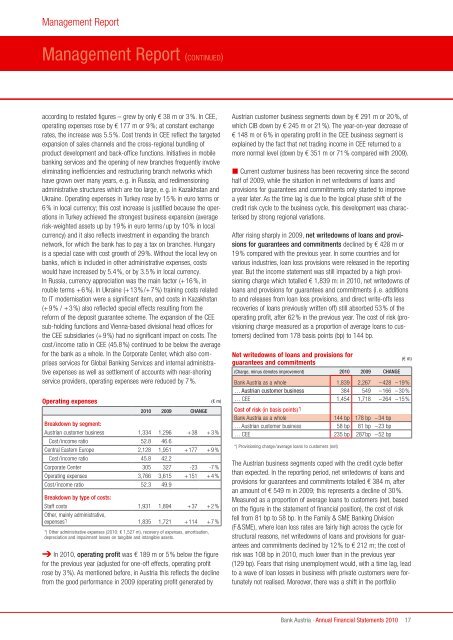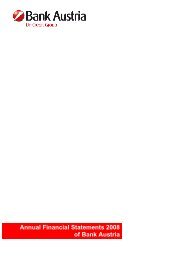Annual Financial Statements 2010 of Bank Austria
Annual Financial Statements 2010 of Bank Austria
Annual Financial Statements 2010 of Bank Austria
Create successful ePaper yourself
Turn your PDF publications into a flip-book with our unique Google optimized e-Paper software.
Management Report<br />
Management Report (CONTINUED)<br />
according to restated figures – grew by only € 38 m or 3%. In CEE,<br />
operating expenses rose by € 177 m or 9%; at constant exchange<br />
rates, the increase was 5.5%. Cost trends in CEE reflect the targeted<br />
expansion <strong>of</strong> sales channels and the cross-regional bundling <strong>of</strong><br />
product development and back-<strong>of</strong>fice functions. Initiatives in mobile<br />
banking services and the opening <strong>of</strong> new branches frequently involve<br />
eliminating inefficiencies and restructuring branch networks which<br />
have grown over many years, e.g. in Russia, and redimensioning<br />
administrative structures which are too large, e.g. in Kazakhstan and<br />
Ukraine. Operating expenses in Turkey rose by 15% in euro terms or<br />
6% in local currency; this cost increase is justified because the operations<br />
in Turkey achieved the strongest business expansion (average<br />
risk-weighted assets up by 19% in euro terms/up by 10% in local<br />
currency) and it also reflects investment in expanding the branch<br />
network, for which the bank has to pay a tax on branches. Hungary<br />
is a special case with cost growth <strong>of</strong> 29%. Without the local levy on<br />
banks, which is included in other administrative expenses, costs<br />
would have increased by 5.4%, or by 3.5% in local currency.<br />
In Russia, currency appreciation was the main factor (+16%, in<br />
rouble terms +6%). In Ukraine (+13%/+7%) training costs related<br />
to IT modernisation were a significant item, and costs in Kazakhstan<br />
(+9% / +3%) also reflected special effects resulting from the<br />
reform <strong>of</strong> the deposit guarantee scheme. The expansion <strong>of</strong> the CEE<br />
sub-holding functions and Vienna-based divisional head <strong>of</strong>fices for<br />
the CEE subsidiaries (+9%) had no significant impact on costs. The<br />
cost/income ratio in CEE (45.8%) continued to be below the average<br />
for the bank as a whole. In the Corporate Center, which also comprises<br />
services for Global <strong>Bank</strong>ing Services and internal administrative<br />
expenses as well as settlement <strong>of</strong> accounts with near-shoring<br />
service providers, operating expenses were reduced by 7%.<br />
Operating expenses (€ m)<br />
<strong>2010</strong> 2009 ChANgE<br />
Breakdown by segment:<br />
<strong>Austria</strong>n customer business 1,334 1,296 +38 +3%<br />
Cost/income ratio 52.8 46.6<br />
Central Eastern Europe 2,128 1,951 +177 +9%<br />
Cost/income ratio 45.8 42.2<br />
Corporate Center 305 327 -23 -7%<br />
Operating expenses 3,766 3,615 +151 +4%<br />
Cost/income ratio 52.3 49.9<br />
Breakdown by type <strong>of</strong> costs:<br />
Staff costs 1,931 1,894 +37 +2%<br />
Other, mainly administrative,<br />
expenses *) 1,835 1,721 +114 +7%<br />
*) Other administrative expenses (<strong>2010</strong>: € 1,527 m), recovery <strong>of</strong> expenses, amortisation,<br />
depreciation and impairment losses on tangible and intangible assets.<br />
➔ In <strong>2010</strong>, operating pr<strong>of</strong>it was € 189 m or 5% below the figure<br />
for the previous year (adjusted for one-<strong>of</strong>f effects, operating pr<strong>of</strong>it<br />
rose by 3%). As mentioned before, in <strong>Austria</strong> this reflects the decline<br />
from the good performance in 2009 (operating pr<strong>of</strong>it generated by<br />
<strong>Austria</strong>n customer business segments down by € 291 m or 20%, <strong>of</strong><br />
which CIB down by € 245 m or 21%). The year-on-year decrease <strong>of</strong><br />
€ 148 m or 6% in operating pr<strong>of</strong>it in the CEE business segment is<br />
explained by the fact that net trading income in CEE returned to a<br />
more normal level (down by € 351 m or 71% compared with 2009).<br />
� Current customer business has been recovering since the second<br />
half <strong>of</strong> 2009, while the situation in net writedowns <strong>of</strong> loans and<br />
provisions for guarantees and commitments only started to improve<br />
a year later. As the time lag is due to the logical phase shift <strong>of</strong> the<br />
credit risk cycle to the business cycle, this development was characterised<br />
by strong regional variations.<br />
After rising sharply in 2009, net writedowns <strong>of</strong> loans and provisions<br />
for guarantees and commitments declined by € 428 m or<br />
19% compared with the previous year. In some countries and for<br />
various industries, loan loss provisions were released in the reporting<br />
year. But the income statement was still impacted by a high provisioning<br />
charge which totalled € 1,839 m: in <strong>2010</strong>, net writedowns <strong>of</strong><br />
loans and provisions for guarantees and commitments (i.e. additions<br />
to and releases from loan loss provisions, and direct write-<strong>of</strong>fs less<br />
recoveries <strong>of</strong> loans previously written <strong>of</strong>f) still absorbed 53% <strong>of</strong> the<br />
operating pr<strong>of</strong>it, after 62% in the previous year. The cost <strong>of</strong> risk (provisioning<br />
charge measured as a proportion <strong>of</strong> average loans to customers)<br />
declined from 178 basis points (bp) to 144 bp.<br />
Net writedowns <strong>of</strong> loans and provisions for<br />
guarantees and commitments<br />
(Charge, minus denotes improvement) <strong>2010</strong> 2009 ChANgE<br />
<strong>Bank</strong> <strong>Austria</strong> · <strong>Annual</strong> <strong>Financial</strong> <strong>Statements</strong> <strong>2010</strong><br />
(€ m)<br />
<strong>Bank</strong> <strong>Austria</strong> as a whole 1,839 2,267 –428 –19%<br />
… <strong>Austria</strong>n customer business 384 549 –166 –30%<br />
… CEE 1,454 1,718 –264 –15%<br />
Cost <strong>of</strong> risk (in basis points) *)<br />
<strong>Bank</strong> <strong>Austria</strong> as a whole 144 bp 178 bp –34 bp<br />
… <strong>Austria</strong>n customer business 58 bp 81 bp –23 bp<br />
… CEE 235 bp 287bp –52 bp<br />
*) Provisioning charge/average loans to customers (net)<br />
The <strong>Austria</strong>n business segments coped with the credit cycle better<br />
than expected. In the reporting period, net writedowns <strong>of</strong> loans and<br />
provisions for guarantees and commitments totalled € 384 m, after<br />
an amount <strong>of</strong> € 549 m in 2009; this represents a decline <strong>of</strong> 30%.<br />
Measured as a proportion <strong>of</strong> average loans to customers (net, based<br />
on the figure in the statement <strong>of</strong> financial position), the cost <strong>of</strong> risk<br />
fell from 81 bp to 58 bp. In the Family & SME <strong>Bank</strong>ing Division<br />
(F&SME), where loan loss rates are fairly high across the cycle for<br />
structural reasons, net writedowns <strong>of</strong> loans and provisions for guarantees<br />
and commitments declined by 12% to € 212 m; the cost <strong>of</strong><br />
risk was 108 bp in <strong>2010</strong>, much lower than in the previous year<br />
(129 bp). Fears that rising unemployment would, with a time lag, lead<br />
to a wave <strong>of</strong> loan losses in business with private customers were fortunately<br />
not realised. Moreover, there was a shift in the portfolio<br />
17
















